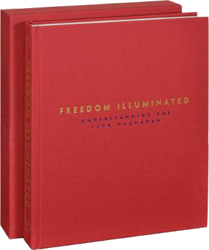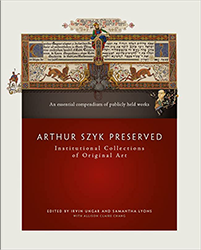Arthur Szyk: Soldier in Art, edited by Irvin Ungar | Jewish Book Council
Artist Arthur Szyk (1894−1951), born in Lodz, Poland, is currently the subject of an important exhibition at the New-York Historical Society. Szyk’s work has not been shown in New York City in over forty years, a surprising omission considering the artist’s prominence as a biting political satirist during World War II, his accomplishments as a book illustrator, and the fact he made his home in the city after immigrating to the United States in 1940.
Irvin Ungar, longtime president of the Arthur Szyk Society, serves as editor for Arthur Szyk: Soldier in Art, a lavishly illustrated, oversize volume with over 200 color plates that bears the same name and revolves around similar themes as the exhibition. While discussing many of the works featured in the show, it is not an exhibition catalogue. Readers will benefit from the longer narrative and the vastly larger amount of material allowed by a book, which offers a fuller picture of Szyk’s diverse body of work.
Szyk is best known for his remarkable Passover Haggadah, characterized by the artist’s signature miniature detailing, akin to medieval manuscript illumination, and strong color. But there are other sides to Szyk’s art: notably scathing war images denouncing Hitler, and fervent pro-Jewish material frequently touting Jewish strength and military prowess.
Take, for example, Battle of the Warsaw Ghetto, which vividly proclaims Jewish grit, specifically in reference to the Warsaw Ghetto uprising. Painted in watercolor and gouache in April 1945, the second anniversary of the uprising, the image portrays male and female fighters, young and old, conquering a representative SS officer lying on the ground with his helmet and gun strewn uselessly around him. One of the Jews mockingly holds up a sign with Himmler’s orders that reads, “Eastern District, Order to the Troops: All Jews must be killed.” Other armed Jews populate the background, which includes a glimpse of the ghetto’s infamous wall, and one proudly holds aloft a Zionist flag. To augment his point, Szyk inscribed words on all four highly decorated borders of the image, inspired by Persian-style miniatures. At the bottom is a dedication to “Samson in the ghetto,” referring to the biblical figure in Judges, which explicitly links Warsaw’s Jews with this strongman who kills his Philistine oppressors even while knowing that he will die, too. Szyk proudly divides this short phrase with two words — “MY PEOPLE,” overlying a Star of David. A phrase around the border bears Szyk’s sentiments toward the Nazis, also biblical in nature: “To the German people, sons of Cain, be ye damned for ever and ever amen.”
Four insightful essays examine Szyk’s artwork — including the powerful Battle of the Warsaw Ghetto—his unique personal style, and his position as an artist-activist during World War II — from his passionate support of Israel to his avid American patriotism.
Samantha Baskind is Distinguished Professor of Art History at Cleveland State University. She is the author or editor of six books on Jewish American art and culture, which address subjects ranging from fine art to film to comics and graphic novels. She served as editor for U.S. art for the 22-volume revised edition of the Encyclopaedia Judaica and is currently series editor of Dimyonot: Jews and the Cultural Imagination, published by Penn State University Press.



